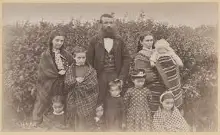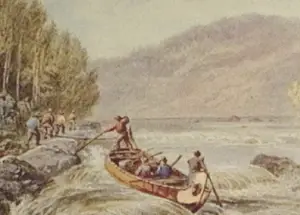The Fur Trade in North America
Early on, the U.S. Government had passed a series of laws intended to regulate the fur trade, in particular with Native Americans. Congress passed the Trade and Intercourse Acts in 1790 and then renewed them every two years until 1802, when a permanent version replaced the temporary ones. Traders were now required to have licenses in order to trade with Native Americans. The laws were intended to prevent Americans from trespassing on lands that Native Americans called home; such laws were often ignored. 
One secondary result of the spread of the fur trade west was the development of the Métis culture. Most of the traders were men, and many of these men married Native American women. Children of these couples were called Métis. As these children grew up, they played an integral part in the sometimes delicate relations between Europeans and native Americans. Métis people were particularly instrumental in the growth of the trade in bison hides, crafting robes and other clothing out of the hides and even selling pemmican at trading posts, alongside bison products. By 1870, because both supply of and demand for animal furs had waned, most fur trading had ended in North America. 
Another influence of the fur trade was on boundaries between the U.S. and Great Britain and, later, Canada. Trading areas controlled by the various colonies/states in the Great Lakes region helped determine state and country borders. The same was true further west, most prominently in the mid-19th Century in what is now Washington. In the same way, the Mountain Men and others who ranged the large swathes of land between the Mississippi River and the Pacific Ocean did much of the exploration of those new lands, discovering new routes for trouble (such as Jedidiah Smith's rediscovery of the South Pass, which became the basis for travel on the California Trail, the Mormon Trail, and the Oregon Trail. First page: In the Beginning > Page 1, 2, 3, 4 |
|
Social Studies for Kids
copyright 2002–2025
David White



 European demand for beaver fur dropped as the 19th Century progressed–in no small part because of the rise in popularity in Europe of felt hats made from silk, not fur–and that economic factor, more than any other, helped bring about the end of the fur trade in North America. Another factor was the severe drop in the number of Native Americans who participated. The French, especially, but later the British traders had built up a system of considerable cooperation and respect with various Native American tribes. American traders, for the most part, did not continue that sort of relationship with Native Americans; in a good many cases, quite the opposite was true.
European demand for beaver fur dropped as the 19th Century progressed–in no small part because of the rise in popularity in Europe of felt hats made from silk, not fur–and that economic factor, more than any other, helped bring about the end of the fur trade in North America. Another factor was the severe drop in the number of Native Americans who participated. The French, especially, but later the British traders had built up a system of considerable cooperation and respect with various Native American tribes. American traders, for the most part, did not continue that sort of relationship with Native Americans; in a good many cases, quite the opposite was true.
